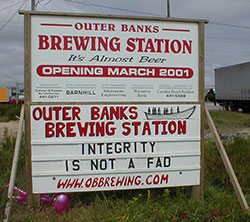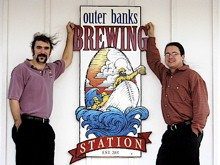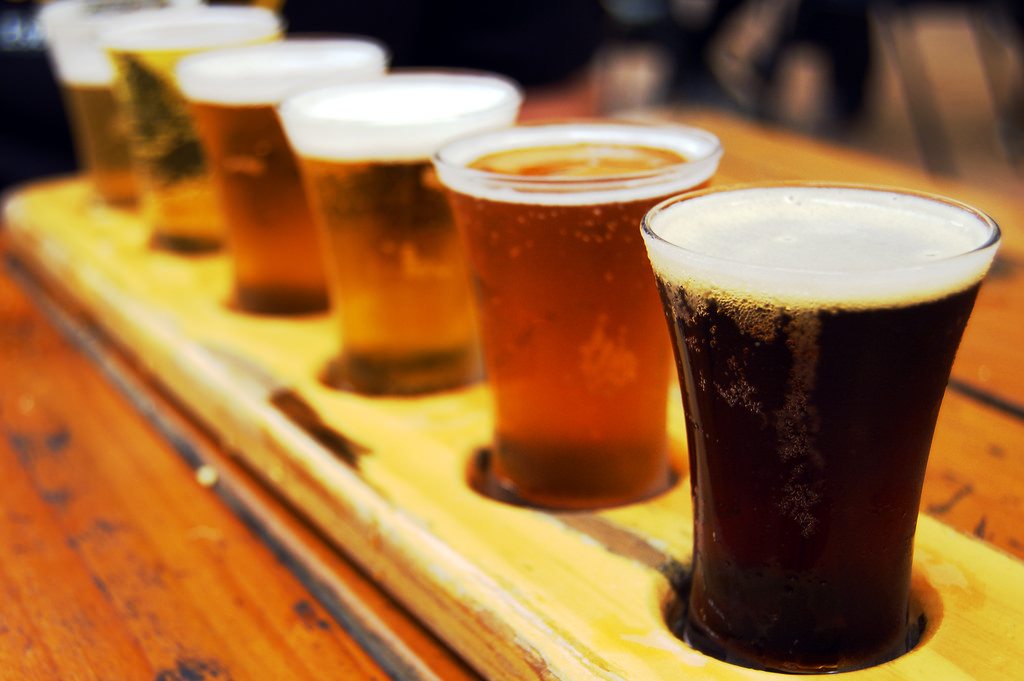On opposite coasts, partners discover brewing art

From Peace Corps to the Outer Banks – Second of three parts
Just down the street from Eric Reece’s Berkeley residence was a microbrewer called Bison Brewing, one of the “seminal pioneers” in the microbrew renaissance.
Reece found himself attracted to the concept and was soon working full time at the famous Telegraph Road pub and learning the art of the brewing process.
“The beer there blew me away,” he said. “I took a 70 percent pay cut when I took that job!”
The brew master at the Bison was Scott Meyer and from Meyer, Reece discovered a new muse.
Many early microbreweries were just ahead of their time, peaking before the microbrew industry swept the country. Like many other pioneers in the fledgling industry, the Bison fell on hard times and Scott took Reece and one other employee to a new gig — the well-known Rosenblum wine facilities, where Scott became a vintner. Reece worked the “grape crush” that year.
Meanwhile on the East Coast, Aubrey Davis was dabbling in home brewing in what little spare time he was able to enjoy.
In 1997 a phone conversation took place between the two friends. Reece related his experiences with microbreweries as Davis talked about his home brew hobby. The original idea of a general merchandise store gives way to a brewpub concept.
“Have any suggestions for a location?” asked Reece. “What about the Outer Banks?” Davis replied.
Reece made the journey and that same year the pair put together a prospectus and began to offer shares to family and friends. Amazingly, they raised enough to purchase the land In Kill Devil Hills where the Brewing Station is now located.

A large parcel meant building a larger pub.
The parcel was so large, their original thought of a smaller scale brew pub had to be abandoned in order to generate sufficient revenues to offset the lot costs. Reece relates, “The land dictated a bigger place and we decided, ‘in for a penny, in for a pound’ was the best course. All of our early, think- small ideas were out the window.”
Reece took up with the Weeping Radish in Manteo and by 1999, Davis had moved into the area and convinced his parents to help with their next hurdle — the bankers. Mackenzie came east with Reece and built a reputation of her own. She worked as a baker at Lone Cedar, the architect of the cupcakes Sen. Marc Basnight gave away to patrons, earning her the nickname “Cupcake.”
Mackenzie was also the motivating force behind Basnight’s cardboard recycling plan at the Lone Cedar. Later she teamed up with the Front Porch to help launch a pilot recycling program for Kill Devil Hills. Carolina Blue, the Red Sky Café and the Weeping Radish also joined the program.
Anxious to move forward, Davis credits three local and regional organizations with making the Brewing Station possible.
First, both aspiring entrepreneurs utilized the Outer Banks Chamber of Commerce’s SCORE program, a group of volunteer, retired executives who help budding entrepreneurs build viable business plans, put together presentations for lenders, as well as teaching them the ins and outs of budgets, operating capital and cost control.

Next in line was visiting bankers. In Greenville, the Self Help Credit Union joined forces with Wachovia Bank. At that time, Ron Bennett, now with Gateway Bank, was the primary loan officer. Self Help specializes in SBA and other government guaranty loan programs and between the two banks a 60-40 percent participation was created and the funds for construction were obtained.
Davis gives huge credit to Bennett’s efforts on their behalf: “Without Ron Bennett, we wouldn’t be sitting here talking to you today.”
Another well-known local figure, architect Ben Cahoon was retained to design the new pub. Given their work in Thailand, Davis and Reece wanted the building to be as green as economically possible. From the old “Hen House” in South Mills, used copper was purchased and utilized in the brewery. Along our shores, bricks used to wash ashore in significant numbers and Tina Mackenzie salvaged them and brought them back to the construction site.
Cahoon had designed the building to be a modern-day representation of the old lifesaving stations that dotted our coastline at the turn of the century. He designed the bar to represent a lifesaving boat, pointed east and ready to be launched down the tracks to the ocean.

Those washed-up bricks, which Reece grew tired of lugging around each time he and Mackenzie moved eventually were sunk into the floor of the Brewing Station and represent the tracks used to launch the boat.
Carolina Beach Builders won the contract for the new establishment. Like most major construction jobs, there were the usual ups and downs, negotiations over costs and tough decisions on which elements had to be cut as dictated by the budget. At one point, 9 feet of width was eliminated from the entire structure to stay within budget.
One story recalled during the construction phase is a classic Outer Banks tale. For decades our beach has been a magnet for refugees from what one might classify as minor brushes with law enforcement. And so it turned out that on the eve of construction, the project manager who had worked with Davis and Reece from the very start of the design phase was extradited to New York on bad check charges.
“Our first actual pre-construction conversation took place over the phone from the hoosegow where our project manager was jailed!” recalled Reece. The project manager never returned; Davis and Reece assumed that role in addition to attempting to hire staff and implement the brew pub’s business model.
As construction on the Outer Banks Brewing Station progressed, Eric Reece and Aubrey Davis began putting together their team. Scott Meyer was first used as a long-distance consultant, but eventually he came east and has been the Brewing Station’s master brewer from the start.
Tina Mackenzie earned her baking certificate from the California Culinary Institute in Berkeley and now handles baking, desserts, wedding cakes and catering for the restaurant.
From Ocean Boulevard, sous chef Todd Bryant came over. When Carolina Moon in Southern Shores closed, OBBS grabbed Pok Choeichom, who grew up working with his mother at the Thai Room.
“We’ve been lucky, but the atmosphere here brings out the talent in the people we have,” Reece notes with pride.

It took five years to win approval for the wind turbine.
The Brewing Station took a different tack on food compared to most other brew pubs.
“We went higher end on our food, and that threw a lot of people off,” says Reece. The pub offered gourmet hamburgers and “we even made our own ketchup!” Davis chimed in.
“While we never planned to become a night club, we also sought to attract night life,” Reece explains, “It seemed every bar had their own special night for bands, so we chose Monday and offered up local bands. We also hired veteran local bartenders who had their own clientele to bring to the brew pub.”
Early headliners were Rhythm Quest and the jazzy sounds of Laura Martier, which paired well with the the dinner crowd.
“Pretty soon we were busting at the seams,” Davis said, and as many locals know, the Brewing Station became a hot spot for the singles scene. Even in the off season, the place is often packed, demonstrating the support of locals, a difficult crowd to maintain with so many bars and so few people residing here in the late fall and winter.
Early on, 70 percent of their sales were generated at the bar and 30 percent from food. As the bar gained acceptance as a foodie and gourmet beer spot, Davis said, “those numbers have now flipped.”
Davis, the engineer, still had one more‘green idea he wanted to implement. Solar was still too expensive, but the Brewing Station wanted some form of passive power to augment reliance on the power grid.
“Sitting in the shadow of the Wright Memorial and taking note of the wind conditions here, a windmill seemed the perfect choice for us,” Davis recalls.
Little did they know how much time would pass before the windmill became a reality. Architect Ben Cahoon was brought back into the planning and Bridge McDowell, a windmill contractor, met with the pair over a period of nine months.
“We gave them a budget and we had no idea what the windmill would contribute financially to our business,” Davis remembers. Reece adds, “People don’t believe us because you have to admit the windmill serves as a landmark and an advertisement for us, but all we really wanted to do was engender conversation about wind power. There were no windmills on this beach at the time, and there should have been one. We wanted to do it.”
Unexpectedly, the pair ran into significant turbulence from the-then Board of Commissioners and some citizens when the idea was floated.
“One man came up to us and told us we would have 9,000 dead birds a year under the windmill,” Davis said. “To date, we’ve not found one dead bird in or around the windmill.”
The pair applied for the windmill in 2002 and it took five years and some changes to the Kill Devil Hills Board of Commissioners before the it was finally approved. They tried a number of approaches to convince the town, at one point offering to donate all of the windmill’s savings to the school system, but in the end, the pair resorted to political activism to help reshape the composition of the town’s board.
Reece says “from the first day, school buses would pull off the road and show it off to the kids. It also saves us $150 to $200 per month in electricity costs. The goodwill it generates is priceless.”
Indeed, the country’s only “wind powered brew pub” has been featured in National Geographic, AAA Magazine and Our State magazine. The pair notes, “This places the Outer Banks on the national map, not just the Brewing Station.”





